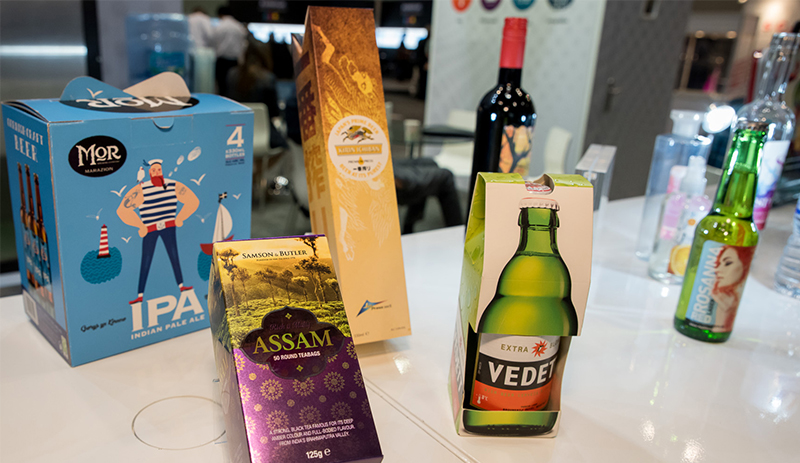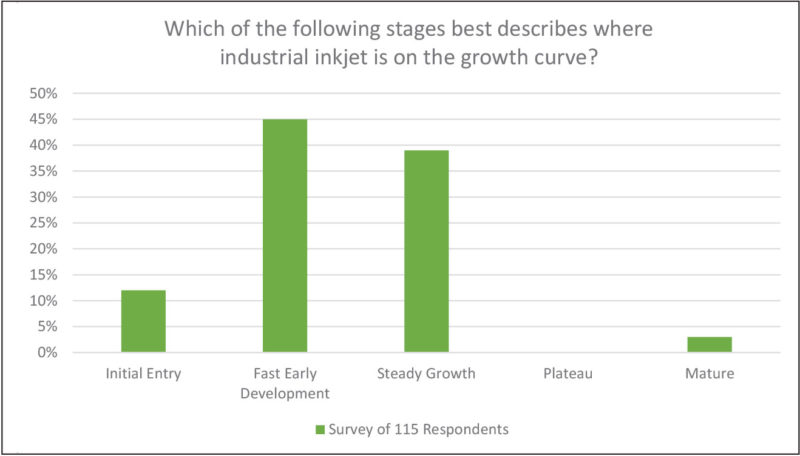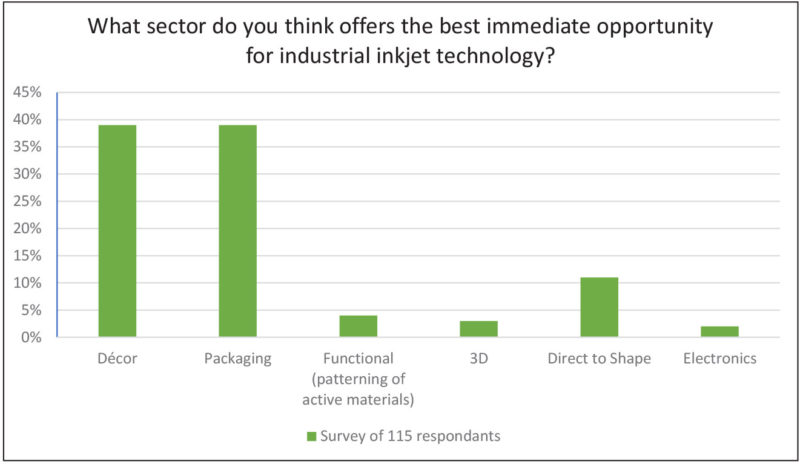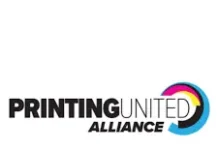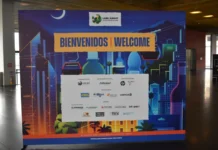Excerpt from InPrint USA white paper: “Industrial Inkjet: Crossing the Chasm?”
Industrial print is the emerging technology for so many facets of manufacturing, allowing for short-run, customized projects for increased profitability without compromising efficiency. As InPrint USA prepares for its 2019 show, it is a good time to ask, where exactly is the industry going and at what pace?
The future of inkjet
In October 2018, InPrint conducted and published an industrial print survey and report called “Industrial Inkjet: Crossing the Chasm?” which focused on the growth of industrial inkjet. InPrint teamed up with research partner I.T. Strategies, an independent, strategic consultancy specialized in industrial digital printing, inkjet technology and early market development practices. InPrint asked 115 respondents their opinion on a variety of issues related to the growth, challenges and opportunities of industrial inkjet. Results compared very favorably to a similar survey conducted in 2017, highlighting an increase in confidence that significant growth will take place throughout the next 12 months.
The report features analysis and commentary from Mark Hanley, president of I.T. Strategies. “These results reflect a market that is confident in the future but also honest about the challenges confronting it today,” Hanley said. “The reality is that inkjet is attempting to enter a very conservative manufacturing industry that is not predisposed to change. The disruptive nature of inkjet is not always welcomed by production professionals who have been brought up in a culture of analog. This is understandable but, nonetheless, frustrating. Growth is going to happen, but in some sectors, inkjet is taking longer than initially expected to find its true role.”
According to the survey, respondents named décor and packaging as the industries with the most immediate opportunity within industrial inkjet technology. Decorative applications include plastics, glass, textiles, flooring and furnishing. Packaging applications ranged from corrugated and folding cartons to flexible packaging, which can be classified as bags, pouches, labels, wraps and more. Over 50% of respondents surveyed chose functional printing as the most technically challenging within industrial inkjet. Nevertheless, most respondents believe the growth curve for industrial inkjet technology is either in the fast, early development stage or steadily growing.
Adopting industrial inkjet technology into a larger production process requires collaboration across the entire supply chain including inks, substrates, software, printheads and machinery. When asked what they considered to be the single most important component to developing industrial inkjet, respondents overwhelmingly chose ink chemistry. It appears the availability of inks has improved in recent years; however, the compatibility between inks and materials still requires development and understanding

Shortly after conducting the report, InPrint hosted a webinar with the same title featuring a panel of experts from leading industrial print companies, gathering their thoughts on the survey from a supplier’s perspective. When discussing the challenges of industrial inkjet adoption, the example of ceramics was highlighted as the perfect storm, where the industry saw substantial inkjet adoption over analog printing.
However, the mass implementation of inkjet technology is still in the early stages, with questions as to why industrial inkjet has not made it into other markets at the same success rate as ceramics. One point made by the panel indicated that the process wasn’t necessarily easier for ceramics, there just happened to be an isolated group focused on developing digital print for ceramics. The industry is currently seeing individual efforts leading development, i.e. ink companies improving inks, print head manufacturers enhancing print heads, but there is not a strong community dedicated to each application and its full potential with industrial inkjet.
“The challenges ahead are as much commercial as they are technical,” said Marcus Timson, co-founder of InPrint. “It seems that traditional print culture is holding back progress but, with the relentless push toward the fully automated digital factor, it is just a matter of time before inkjet makes the leap across the chasm for a number of new markets.”
Explore the latest industrial print solutions for functional, decorative and package printing at InPrint USA, which will be held April 9-11, 2019, at the Kentucky International Convention Center in Louisville. For the full report on industrial inkjet referenced in this article, and to register, visit inprintusaexhibition.com.
InPrint 2019 Offers Something for Everyone
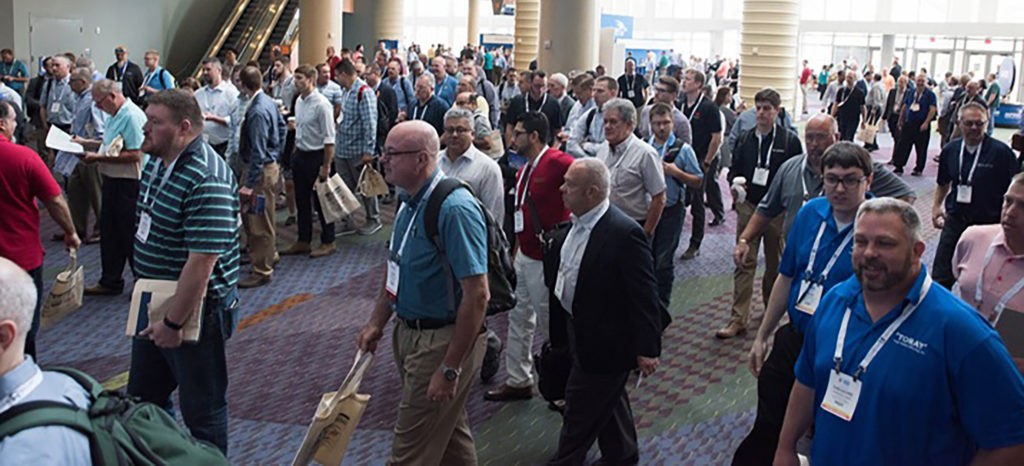
Growing with the industry
New show features at InPrint USA 2019 promise to deliver opportunities for education and engagement on the growth of industrial inkjet, as well as digital, specialty and screen print solutions for manufacturing integration. Whether visitors are new to the industry or have been in it for a while, there will be something for everyone to take away from the event.
InPrint USA is co-located with the ICE USA, the International Converting Exhibition, and both shows have established a new partnership with the Flexible Packaging Association (FPA), which has served as the voice of the flexible packaging industry since 1950. The Flexible Packaging Pavilion, located on the show floor, will allow visitors of both shows to cross-educate on the latest flexible packaging solutions in the printing and converting industry.
Returning to InPrint is IMI Tech Talks, where leading OEMs highlight the latest developments and challenges within industrial inkjet technology. Tech Talks will run within InPrint’s highly attended conference program at the InPrint Theater, located on the show floor.
Location, location, location
“According to Forbes, Louisville ranked number one in the nation for manufacturing and continues to stay in the top 10 going into 2019,” said Christina Molina, InPrint USA show manager. “Being centrally located between the Midwest and Northeast regions of the US, and within a day’s drive to more than half of the population, puts the InPrint show strategically in a great spot to attract key visitors our exhibitors want to meet.”
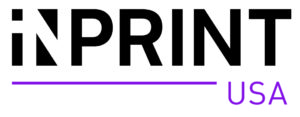 InPrint visitors consist of brand owners, CTOs, R&D directors, production developers and designers, end users and more. Some key companies that attended last year’s show include Boeing, Nike, Coca-Cola, Proctor & Gamble, Hallmark, Kimberly Clark and GE Appliances.
InPrint visitors consist of brand owners, CTOs, R&D directors, production developers and designers, end users and more. Some key companies that attended last year’s show include Boeing, Nike, Coca-Cola, Proctor & Gamble, Hallmark, Kimberly Clark and GE Appliances.
To help identify key visitors, InPrint established new partnerships with leading end user groups for the 2019 show, proving the need for a dedicated forum of print in manufacturing. To date, these include:
- Wallcoverings Association
- Kentucky Automotive Industry Association
- Flexible Packaging Association
- National Association of Printing Ink Manufacturers
- National Graphene Association
“We are very excited about the partnership with InPrint USA,” said Dave Tatman, executive director of the Kentucky Automotive Industry Association (KAIA). “It is critical for our members to be aware of new solutions and cutting-edge technology for automotive manufacturing, and we are thrilled that InPrint USA is bringing solution providers to our backyard.”
InPrint USA will be April 9-11, 2019, at the Kentucky International Convention Center in Louisville. For more information, visit inprintusaexhibition.com and register today.

